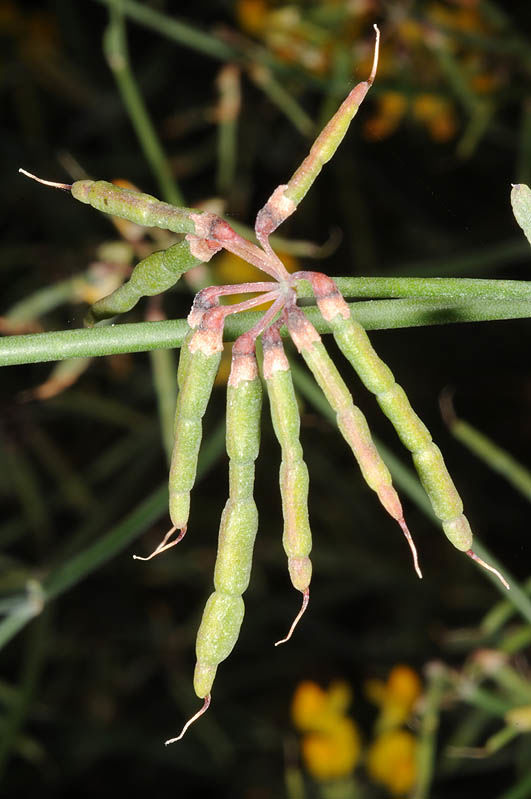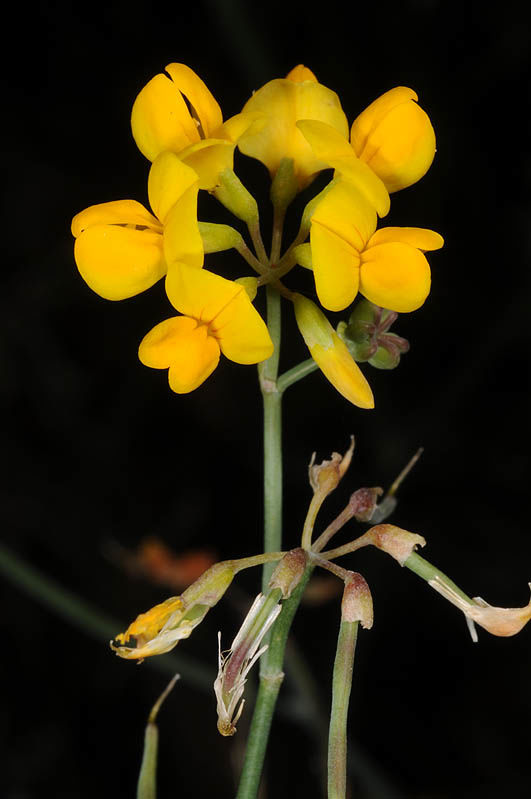Yellow Serradella
coronilla valentina
Also known as: ["Valentine's Coronilla","Yellow Crown","False Serradella"]
Overview
A deciduous shrub native to the Mediterranean region, valued for its bright yellow flowers and hardy nature.
Benefits & Perks
["long-flowering","drought tolerant","wildlife attractant (bees, butterflies, birds)"]
Botanical Classification
| Phylum: | Magnoliophyta |
| Class: | Magnoliopsida |
| Order: | Fabales |
| Family: | Fabaceae |
| Genus: | Coronilla |
| Botanical Name: | Coronilla valentina |
Plant Characteristics
Basic Information
- Category: Shrubs
- Suitable Location: outdoor garden in a sunny spot
- Suitable For:
- Is Weed: No
- Allergenicity: low
Environmental Needs
- Climate: {"temperatureRange":"–10–35°C"}
- Hardiness: {"zones":"5–9"}
- Misting: rarely required
- Drainage: Fast-draining to prevent waterlogging.
- Soil Type: Well-draining, loamy soil with added organic matter; can tolerate poor soils but thrives with enrichment.
Maintenance Level
- Maintenance Level: moderate
- Toughness Level: high
- Pruning Frequency: Annually after flowering or every 2–3 years to rejuvenate growth.
- Pruning Intensity: Moderate; remove up to one-third of old growth to stimulate new shoots.
Care Details
Ideal Sunlight Coverage:
Full sun (6–8 hours of direct sunlight daily); tolerates partial shade but may become leggy with insufficient light.
Sunlight Tolerance Tips:
Acclimate gradually if moving from shade to sun; protect from intense midday sun in hot climates; ensure good air circulation to prevent fungal issues.
Care Requirements
Care Difficulty
moderatemoderate
Sunlight
full sun to partial shade
Rotate plant weekly for even growth; use sheer curtains to filter harsh sunlight; place outdoors in summer for optimal light.
Watering
every 7–10 days during active growth, reduce in winter
Water thoroughly until it drains from the bottom, avoid frequent shallow watering, and adjust frequency based on season and weather.
Soil
well-drained, sandy loam
pH: Slightly alkaline to neutral (pH 6.5–7.5).
Ensure pots have drainage holes; avoid heavy clay soils; topdress with compost annually.
Temperature
Prefers 60–75°F (15–24°C); tolerates mild frosts but thrives in moderate temperatures; avoid prolonged exposure to extreme heat or cold.
Avoid placing near drafty windows or heating vents; adjust watering based on temperature fluctuations; monitor for signs of stress.
Fertilizing
every 4–6 weeks during spring and summer
Fertilize only when actively growing; flush soil occasionally to prevent salt buildup; use organic options like compost tea for gentle feeding.
Propagation
Methods
Stem cuttings or seed; stem cuttings are more reliable for home growers.
Step-by-Step Propagation Guide
- Take 4–6 inch cuttings.
- Remove lower leaves.
- Dip in rooting hormone.
- Plant in medium.
- Keep moist and warm.
Best Time: Spring or early summer when the plant is actively growing.
Environment
Warm (70–75°F), humid (60–70%), and bright indirect light; protect from direct sun.
Medium
Well-draining mix of perlite and peat moss or cactus mix.
Hormone
Recommended to use rooting hormone for faster and more reliable rooting.
Timeline
Roots typically form in 3–6 weeks; new growth may appear in 2–3 months.
Tools Needed
Pruning shears, rooting hormone, small pots, well-draining medium, misting bottle.
Quick Tips
Use healthy, non-flowering stems; maintain consistent moisture; provide bottom heat for faster rooting.
Pruning & Repotting
Pruning Guide
Method
Selective thinning of branches; heading back to encourage bushiness; remove crossing or crowded stems.
Pruning Plan
Prune to maintain shape, encourage bushier growth, and remove dead or diseased parts; best done after flowering or in early spring.
Tools
Pruning shears, loppers (for larger branches), sterilizing solution.
Checklist
Sterilize tools; prune during dormancy or after flowering; make clean cuts just above buds or nodes.
Repotting Guide
Best Season
Early spring before new growth begins.
Pot Size
Increase pot size by 2–3 inches in diameter; ensure good drainage holes.
Method
Remove plant gently; trim any circling roots; place in a slightly larger pot with fresh, well-draining soil; water thoroughly after repotting.
Suggestions
Repot every 2–3 years or when roots fill the pot; beneficial for younger plants to encourage growth.
Checklist
Check root bound status; prepare new pot with drainage; use fresh soil mix; water after repotting.
Advanced Care Tips
Watering Mastery
Watering Checklist
Check soil moisture before watering; water deeply; ensure drainage; adjust for season.
How to Apply Water Properly
Water directly at the root zone, ensuring even moisture distribution; water early in the morning to minimize evaporation; allow excess water to drain completely to prevent root rot.
Watering Schedule Tips
Water deeply once every 7–10 days during active growth in spring and summer; reduce frequency to every 2–3 weeks in fall and winter, allowing soil to dry completely between waterings.
Soil Improvement
Add perlite or coarse sand for drainage; incorporate compost for fertility; use lime to raise pH if needed.
Temperature Stress Management
Signs of Temperature Issues
Yellowing leaves or leaf drop in cold stress; wilting, scorching, or stunted growth in heat stress.
Cold Stress
Slows growth, may cause leaf drop, and can lead to root damage if temperatures drop below 20°F (-6°C).
Solution: Move to a sheltered location or indoors during frost; use frost cloth for outdoor protection; ensure good drainage to prevent cold soil compaction.
Hot Stress
Leaves may wilt, scorch, or drop; growth may slow; soil may dry out too quickly.
Solution: Provide afternoon shade; increase watering frequency; use mulch to retain soil moisture; mist foliage during extreme heat.
Fertilizing Guide
Fertilizing Checklist
Check growth phase; dilute fertilizer correctly; apply to moist soil; avoid contact with roots.
Fertilizing Method
Use balanced liquid fertilizer diluted to half strength every 4–6 weeks during spring and summer; avoid fertilizing in fall and winter.
Common Problems & Solutions
Toxicity Warning
Cats
Slightly ToxicCats are susceptible to mild toxicity from Coronilla valentina if they consume the seeds or leaves. The plant's alkaloids can cause gastrointestinal and neurological symptoms, which may require medical intervention.
⚠️ Symptoms:
🌿 Toxic Parts:
⚡ Toxic If:
if eaten
Dogs
Slightly ToxicIn dogs, ingestion of Coronilla valentina can lead to mild to moderate gastrointestinal upset and neurological disturbances. The toxic compounds in the seeds and leaves can cause discomfort and require veterinary attention if symptoms persist.
⚠️ Symptoms:
🌿 Toxic Parts:
⚡ Toxic If:
if eaten
Humans
Slightly ToxicCoronilla valentina contains toxic compounds that can cause mild gastrointestinal distress and neurological symptoms if ingested in significant quantities. The plant's seeds and leaves are the primary toxic parts, containing alkaloids that affect the nervous system and digestive tract.
⚠️ Symptoms:
🌿 Toxic Parts:
⚡ Toxic If:
if eaten
Frequently Asked Questions
Q: Is Coronilla valentina suitable for dry climates?
A: Yes, it is highly drought-tolerant and thrives in arid conditions.
Q: Does this plant attract wildlife?
A: Yes, it is known to attract bees, butterflies, and birds due to its nectar-rich flowers.
Q: How often should I water Coronilla valentina?
A: Water sparingly, as overwatering can lead to root rot; established plants require minimal watering.
Quick Reference
| Family: | Fabaceae |
| Care: | moderate |
| Light: | full sun to partial shade |
| Water: | every 7–10 days during activ |
Get Expert Care Tips
Download the Plantious app for personalized care reminders and plant identification!
Google Play App Store








